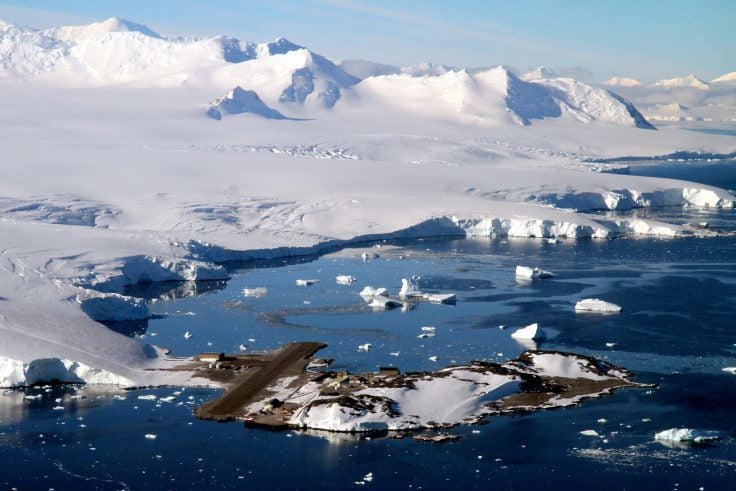
It’s been over two and a half years since an online Twitter campaign failed to rename the UK’s next polar research vessel ‘Boaty McBoatface’. Opinions are still divided on this decision, but scientists remain focused on the ground-breaking facilities the RRS Sir David Attenborough (RRS SDA) will offer when it commences operations in 2019.
The vessel will feature an enclosed science hangar to house containerised laboratories, 650m of clear deck space and a unique ‘moon pool’ concept that will facilitate easier subsea vessel deployment. However, a pressing concern for polar research stations is the ship’s colossal size.
With a length of 129m, the RRS SDA is significantly larger than the UK’s existing polar flagships – the RRS James Clark Ross and RRS Ernest Shackleton – and its cargo crane juts out at the rear, making unloading operations impossible at a dwarfish wharf.
British Antarctic Survey (BAS) is in the process of carrying out a major modernisation programme at Rothera Research Station, the UK’s main Antarctic hub for biological and scientific research. Launched in November 2018, the first phase of this project will involve a major rebuild of the Biscoe Wharf, first built to facilitate vital shipping activities in the 1990s.
The lengthier wharf will be able to accommodate the RRS SDA and provide a variety of new benefits for small boating operations. However, the logistics of the construction are staggering to say the least.
An intercontinental supply mission

How well do you really know your competitors?
Access the most comprehensive Company Profiles on the market, powered by GlobalData. Save hours of research. Gain competitive edge.

Thank you!
Your download email will arrive shortly
Not ready to buy yet? Download a free sample
We are confident about the unique quality of our Company Profiles. However, we want you to make the most beneficial decision for your business, so we offer a free sample that you can download by submitting the below form
By GlobalDataRebuilding the wharf will take place in two stages. Starting in December 2018, the existing 60m wharf will be dismantled, while cargo and small boat operations will be relegated to a temporary jetty at nearby South Cove.
A team of 50 workers employed by construction giant BAM have bunkered down at the site to construct the rear section of the new 74m-long wharf. The second season will see the construction of the new wharf’s front section, as well as the extraction of equipment, staff and materials for recycling offsite.
“The new design is similar to the existing one, which has performed very well over the past 27 years,” says BAS project manager David Seaton. “We have larger forces applied to the new wharf because the RRS SDA is so much bigger than our current ships. Also, we have strengthened areas which are more vulnerable to iceberg damage.”
In November 2018, the DS Wisconsin departed from Teesport, UK, on an 11,000km journey to Rothera, having crammed almost 4,000 tonnes of equipment and materials onboard. This included two 300-tonne crawler cranes, drilling rigs, and around 1,000 tonnes of structural steelwork.
“We can’t wait until the second season because there wouldn’t be a way of getting it ashore, so we have to be very organised,” says Seaton. “We have to take lots of spares with us because it can take quite a long time to get spares, but also if there are big parts then it’s very difficult to get them there.”
Offloading times at Rothera can be lengthy, and the existing wharf is no stranger to disruption due to inclement weather – particularly when it comes to ice. BAS has a full-time weather specialist and ‘observers’ onsite to monitor ice thickness, but it’s still difficult to predict when berthing operations will be suspended.
“The ice is an interesting one because you just don’t know what’s going to happen,” he says. “Some seasons there can be quite a lot of bergs, and of all different sizes.
“We may have months where we have no issues at all, and then we may find there are some weeks where we have to react to ice constantly. On average, our programme takes account of a certain amount of ice disruption. If we have a particularly bad year, then we could be delayed.”
Construction challenges

Building a new wharf on a steep underwater slope is a challenge in itself, let alone doing so while a busy airport continues to operate next door.
“It is a tight site and there is not much space to accommodate some very large plant as well as the laydown areas for materials,” says Seaton. “The runway is right next to the water so it means we can’t have tall cranes with their booms up with the planes taking off and landing.”
Construction of the wharf is primarily being carried out across the Antarctic summers, when the station experiences sunlight for up to 24 hours a day. However, construction staff will also need to take regular breaks to get warm and boost their calorie intake.
The construction must also adhere to strict environmental standards. BAS submitted a comprehensive evaluation to the Antarctic Committee for Environmental Protection earlier this year. Seaton says the plan significantly reduces the amount of underwater blasting and drilling work, and stipulates a 1.2km exclusion zone where no underwater noise will be permitted when mammals and birds are within its radius.
“There are no concreting operations on site, just some grout bags,” he adds. “We are using locally won aggregate rather than importing foreign material. We are setting up a number of monitoring stations so we can assess the impact of dust and noise.”
The biggest challenge, however, will be ensuring that around 100 staff living and working at Rothera do not see operations hindered by the wharf’s construction. Cargo ships deliver food, fuel and cargo too large to be transported via air several times a year, while rigid-hulled inflatable boats are deployed to collect samples to aid scientific research.
“We still have to refuel the station and carry out station relief,” says Seaton. “This will be done using the temporary jetty we are going to construct in South Cove, but we will have to use cargo tender and also pump fuel from the ship using a lay-flat hose on the water all the way to the fuel farm.”
BAS has developed a comprehensive station integration plan, including daily site briefings to ensure scientists and station staff are kept abreast of developments. Blasting works will also be carefully controlled and timed in agreement with the station.
Supporting a polar revolution

Once completed, the new wharf is set to offer long-lasting benefits for Rothera. The larger RRS SDA vessel has been built to carry more cargo, and is set reduce the station’s relief time from four days to two, thereby freeing up the ship to carry out more scientific activities.
The new wharf will also introduce a larger crane for launching small boats, a personnel gangway, and a floating pontoon for deploying scientific instruments such as gliders. Recycled materials will be used in the wider modernisation programme at Rothera, including the construction of new buildings, an improved airport hangar and a landing strip.
The Rothera research station is just a small part of the UK’s overall investment in polar research, its largest in Antarctic and Arctic infrastructure since the 1980s. And the RRS SDA is the tip of the iceberg. For Seaton, many aspects of the build are ‘fingers crossed’, but he seems confident about its success, and says that it could provide important logistic lessons for future station renovations.
Images courtesy of BAS.







